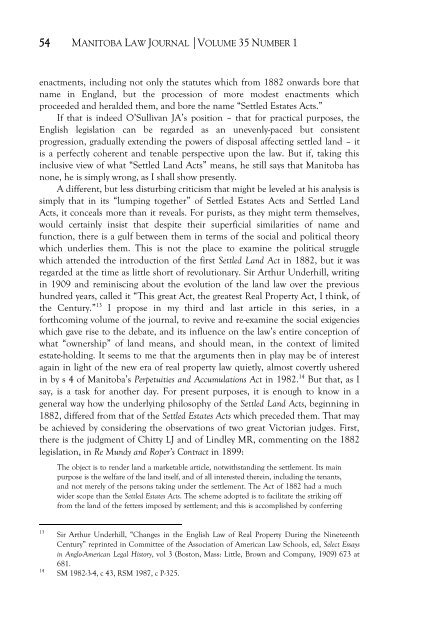Download PDF - Robson Hall Faculty of Law
Download PDF - Robson Hall Faculty of Law
Download PDF - Robson Hall Faculty of Law
You also want an ePaper? Increase the reach of your titles
YUMPU automatically turns print PDFs into web optimized ePapers that Google loves.
54 MANITOBA LAW JOURNAL |VOLUME 35 NUMBER 1<br />
enactments, including not only the statutes which from 1882 onwards bore that<br />
name in England, but the procession <strong>of</strong> more modest enactments which<br />
proceeded and heralded them, and bore the name “Settled Estates Acts.”<br />
If that is indeed O’Sullivan JA’s position – that for practical purposes, the<br />
English legislation can be regarded as an unevenly-paced but consistent<br />
progression, gradually extending the powers <strong>of</strong> disposal affecting settled land – it<br />
is a perfectly coherent and tenable perspective upon the law. But if, taking this<br />
inclusive view <strong>of</strong> what “Settled Land Acts” means, he still says that Manitoba has<br />
none, he is simply wrong, as I shall show presently.<br />
A different, but less disturbing criticism that might be leveled at his analysis is<br />
simply that in its “lumping together” <strong>of</strong> Settled Estates Acts and Settled Land<br />
Acts, it conceals more than it reveals. For purists, as they might term themselves,<br />
would certainly insist that despite their superficial similarities <strong>of</strong> name and<br />
function, there is a gulf between them in terms <strong>of</strong> the social and political theory<br />
which underlies them. This is not the place to examine the political struggle<br />
which attended the introduction <strong>of</strong> the first Settled Land Act in 1882, but it was<br />
regarded at the time as little short <strong>of</strong> revolutionary. Sir Arthur Underhill, writing<br />
in 1909 and reminiscing about the evolution <strong>of</strong> the land law over the previous<br />
hundred years, called it “This great Act, the greatest Real Property Act, I think, <strong>of</strong><br />
the Century.” 13 I propose in my third and last article in this series, in a<br />
forthcoming volume <strong>of</strong> the journal, to revive and re-examine the social exigencies<br />
which gave rise to the debate, and its influence on the law’s entire conception <strong>of</strong><br />
what “ownership” <strong>of</strong> land means, and should mean, in the context <strong>of</strong> limited<br />
estate-holding. It seems to me that the arguments then in play may be <strong>of</strong> interest<br />
again in light <strong>of</strong> the new era <strong>of</strong> real property law quietly, almost covertly ushered<br />
in by s 4 <strong>of</strong> Manitoba’s Perpetuities and Accumulations Act in 1982. 14 But that, as I<br />
say, is a task for another day. For present purposes, it is enough to know in a<br />
general way how the underlying philosophy <strong>of</strong> the Settled Land Acts, beginning in<br />
1882, differed from that <strong>of</strong> the Settled Estates Acts which preceded them. That may<br />
be achieved by considering the observations <strong>of</strong> two great Victorian judges. First,<br />
there is the judgment <strong>of</strong> Chitty LJ and <strong>of</strong> Lindley MR, commenting on the 1882<br />
legislation, in Re Mundy and Roper’s Contract in 1899:<br />
The object is to render land a marketable article, notwithstanding the settlement. Its main<br />
purpose is the welfare <strong>of</strong> the land itself, and <strong>of</strong> all interested therein, including the tenants,<br />
and not merely <strong>of</strong> the persons taking under the settlement. The Act <strong>of</strong> 1882 had a much<br />
wider scope than the Settled Estates Acts. The scheme adopted is to facilitate the striking <strong>of</strong>f<br />
from the land <strong>of</strong> the fetters imposed by settlement; and this is accomplished by conferring<br />
13<br />
14<br />
Sir Arthur Underhill, “Changes in the English <strong>Law</strong> <strong>of</strong> Real Property During the Nineteenth<br />
Century” reprinted in Committee <strong>of</strong> the Association <strong>of</strong> American <strong>Law</strong> Schools, ed, Select Essays<br />
in Anglo-American Legal History, vol 3 (Boston, Mass: Little, Brown and Company, 1909) 673 at<br />
681.<br />
SM 1982-3-4, c 43, RSM 1987, c P-325.














